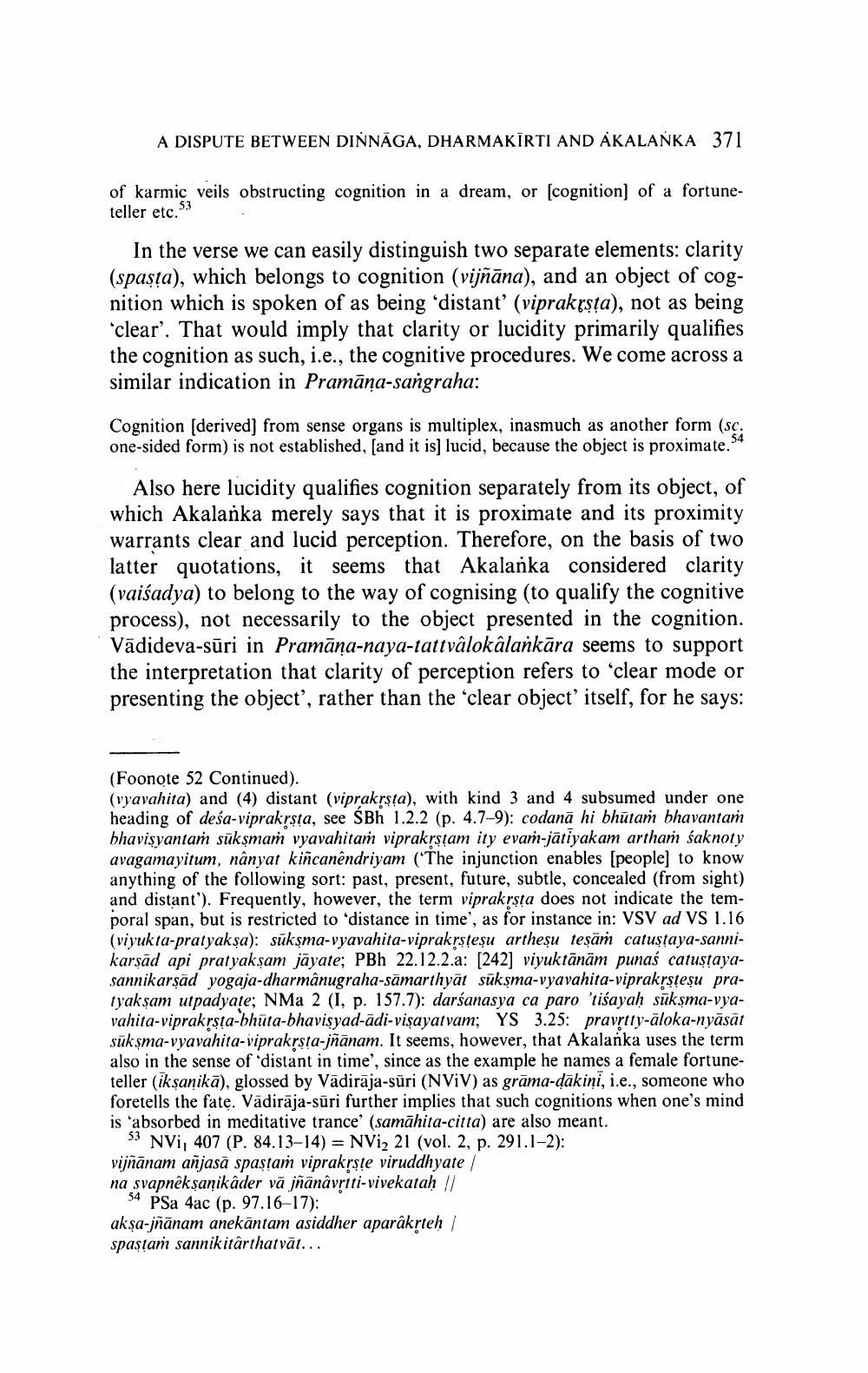________________
A DISPUTE BETWEEN DINNĀGA, DHARMAKĪRTI AND AKALANKA 371
of karmic veils obstructing cognition in a dream, or (cognition) of a fortuneteller etc..
In the verse we can easily distinguish two separate elements: clarity (spasta), which belongs to cognition (vijñāna), and an object of cognition which is spoken of as being distant' (viprakçșța), not as being "clear’. That would imply that clarity or lucidity primarily qualifies the cognition as such, i.e., the cognitive procedures. We come across a similar indication in Pramāna-sangraha:
Cognition (derived) from sense organs is multiplex, inasmuch as another form (sc. one-sided form) is not established, (and it is) lucid, because the object is proximate. 94
Also here lucidity qualifies cognition separately from its object, of which Akalanka merely says that it is proximate and its proximity warrants clear and lucid perception. Therefore, on the basis of two latter quotations, it seems that Akalanka considered clarity (vaišadya) to belong to the way of cognising (to qualify the cognitive process), not necessarily to the object presented in the cognition. Vādideva-sūri in Pramāņa-naya-tattvâlokālankāra seems to support the interpretation that clarity of perception refers to 'clear mode or presenting the object', rather than the 'clear object itself, for he says:
(Foonote 52 Continued). (vyavahita) and (4) distant (viprakrsta), with kind 3 and 4 subsumed under one heading of deśa-viprakrsta, see SBh 1.2.2 (p. 4.7-9): codanā hi bhūtam bhavantam bhavisyantam sūkşma vyavahitam viprakrstam ity evam-jātiyakam artham saknoty avagamayitum, nânyat kiñcanêndriyam ("The injunction enables (people) to know anything of the following sort: past, present, future, subtle, concealed (from sight) and distant'). Frequently, however, the term viprakrsta does not indicate the temporal span, but is restricted to distance in time', as for instance in: VSV ad VS 1.16 (viyukta-pratyak şa): sūkşma-vyavahita-viprakrsteșu artheșu teşām catustaya-sannikarşād api pratyakşam jāyate; PBh 22.12.2.a: [242] viyuktānām punaś catustayasannikarşād yogaja-dharmânugraha-sāmarthyāt sūksma-vyavahita-viprakrsteșu pratyakşam utpadyate; NMa 2 (I, p. 157.7): darśanasya ca paro 'tiśayah sūksma-vyavahita-viprakrsta-bhūta-bhavisyad-ādi-visayatvam; YS 3.25: pravrtty-āloka-nyāsāt sūksma-vyavahita-viprakrsta-jñānam. It seems, however, that Akalanka uses the term also in the sense of distant in time', since as the example he names a female fortuneteller (ik şanikā), glossed by Vădirāja-sūri (NViV) as grāma-dakini, i.e., someone who foretells the fate. Vādirāja-sūri further implies that such cognitions when one's mind is 'absorbed in meditative trance' (samāhita-citta) are also meant.
53 NVi, 407 (P. 84.13-14) = NVi2 21 (vol. 2, p. 291.1-2): vijñānam añjasā spastam viprakrste viruddhyate / na svapnêksanikâder vā jñanavrtti-vivekataḥ //
54 PSa 4ac (p. 97.16-17): akşa-jñānam anekāntam asiddher aparâkrteh / spastam sannikitarthatvāt...




